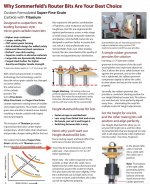jeffinsgf said:The lift has about 3-3/8" of travel and a 2" cut length bit is 4" long...about 5/8" of which belongs in the collet. My guess is, your router motor is clamped too high in the lift...mine was until 10 minutes ago. I had experienced the same issue yesterday, and your message prompted me to take a look. At the top of the travel, the collet was completely out of the table...handy for bit changes if you don't have offset wrenches, but mine was at least a half inch higher than it needed to be for straight wrench changes. I use offset wrenches, so I reset the motor so the collet is just flush with the top of the plate at the top of the travel. If you have straight wrenches, set your motor so the lower nut is just at table height at the top of the travel. Then you'll be able to bury just about any bit made.
Ah that explains that. I was following the video that you posted about setup. Whats the correct procedure to reset it? Do you sell offset er20 wrenches? i saw that they are included with the spinrite motor. I haven't found offset wrenches for er20 for sale for some reason.

